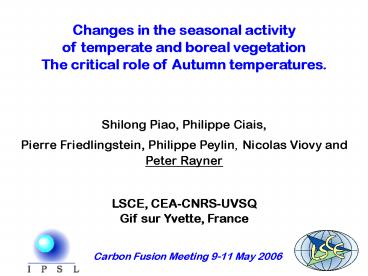Changes in the seasonal activity - PowerPoint PPT Presentation
1 / 19
Title:
Changes in the seasonal activity
Description:
Changes in the seasonal activity. of temperate and boreal vegetation ... the spatial distribution in the CO2 seasonal cycle - regional trends detection ... – PowerPoint PPT presentation
Number of Views:193
Avg rating:3.0/5.0
Title: Changes in the seasonal activity
1
Changes in the seasonal activity of temperate
and boreal vegetation The critical role of Autumn
temperatures. Shilong Piao, Philippe Ciais,
Pierre Friedlingstein, Philippe Peylin,
Nicolas Viovy and Peter Rayner LSCE,
CEA-CNRS-UVSQ Gif sur Yvette, France
Carbon Fusion Meeting 9-11 May 2006
2
Background
As temperature is rising, the length of growing
season usually increases.
How will the net Carbon Uptake Period respond to
the warming ?
3
Global biospheric model ORCHIDEE
4
ORCHIDEE model simulations
- Spin up (1000 y) using 1901 climate data, and
1850 CO2 concentration - Simulate from 1850 to 1900 using 1901-1910
climate data, and corresponding every year CO2
concentration. - Simulate from 1901 to 2002, using corresponding
every year climate data and CO2 concentration.
Save every day C flux from 1980 to 2002.
5
Comparison of spring (AM) LAI
Latitude (degree)
6
Comparison of autumn (SO) LAI
Latitude (degree)
7
Interannual Variability in LAI
Spring SDORCHIDEE 0.04 SDGIMMS 0.06 SDPAL
0.19
Autumn SDORCHIDEE 0.02 SDGIMMS 0.07 SDPAL
0.13
8
Define growing season and carbon uptake periods
CUP
GSL
Growing Season From rate of change of LAI
Carbon Uptake From NEP zero-crossing dates
C net carbon uptake start D net carbon
uptake end CD Carbon Uptake Period (CUP)
A growing season start B growing season
end AB growing season length (GSL)
9
Carbon Uptake
Growing season (phenology)
Mapping the growing season and carbon uptake
timing
Onset date increases with increasing latitude
CUP start occurs later than GS start (because of
spring respiration)
Start (day)
The distribution of End date in autumn is less
uniform than in spring, (reflects vegetation
type, as well as water / temperature limitations
on plant growth).
End (day)
Shortest GSL Central Siberia near the Arctic
coast (4 months). Shortest CUP Northern
Eurasian forests and water limited steppes - also
show the shortest GS length.
Duration (days)
Derived from ORCHIDEE simulation
10
Trends GSL and CUP during 1980-2002
Spring
dGSLstart/dt 0.16 days/yr dCUPstart/dt 0.19
days/yr Same response of CUPstart and GSLstart to
warming trend RGSLstart-temp -0.91
Plt0.001 RCUPstart-temp -0.62 P0.002
Autumn
dGSLend/dt 0.14 days/yr dCUPend/dt -0.07
days/yr Opposite response of CUPend and GSLend to
warming trend ! RGSLend-temp 0.71 Plt0.001
RCUPend-temp -0.51 P0.01
ORCHIDEE gt 25N
11
Carbon Uptake Trends
Growing season Trends
Mapping the trends
More than 70 of the study region exhibits an
advancing trend in the GSL start, especially in
Eurasia. In North America, large regions show
delayed trends in the CUP start
Beginning
GSL most of northern North America shows a trend
towards later GSL end, BUT there is a trend to
earlier GSL end in temperate Western Eurasia
(Europe). CUP 70 of the study region display a
trend towards an earlier CUP end.
End
GSL length Trends to increasing GSL over high
latitude regions, usually as a result of earlier
beginning of growing season in Eurasia and later
end of growing season in North America CUP
length North America shows a trend to shorter
CUP length, Eurasia has the opposite behaviour
Length
Derived from ORCHIDEE
12
Comparison with satellite observation
Spring
Autumn
(1) Period from 1980-2002 (2) Period from
1982-1998 (3) Period from 1988-2000
13
Atmosphere CO2 measurements
- Although Keeling et al. (1996) found that there
were no significant long-term changes in the
upward zero crossing time at site Mauna Loa from
mid-1970s to 1994, pronounced advancement at a
rate of 0.77 days yr-1 (R-0.65, P0.001) is
observed in the period of 1980-2002.
14
Temperature vs. Carbon Uptake Period
Spring RBRW -0.85, Plt0.001 RMLO -0.40, P0.056
Autumn RBRW -0.60, P0.003 RMLO -0.59,
P0.005 (excluding 1992, 1993)
15
Differential response of gross C Fluxes to the
warming trend in Northern Hemisphere (gt25N)
Spring Warm temperatures accelerate growth more
than soil decomposition. The annual relationship
of NEP to temperature is positive gt Warming
enhances carbon uptake
Autumn Warm autumn accelerate growth less than
soil decomposition. The annual relationship of
flux to temperature is negative. gt Warming
reduces carbon uptake
Derived from ORCHIDEE
16
Autumn (SON) temperature vs. C Flux
Derived from ORCHIDEE
17
Conclusion
- Most of the study region exhibited extending of
GSL, usually as a result of earlier vegetation
green-up in Eurasia and later vegetation
senescence in North America, which strongly
supports a lengthening of growing season and
greening trend at northern hemispheric observed
in the past two decades. - Due to parallel stimulating soil carbon
decomposition, increase in GSL does not
necessarily lead to increase in CUP and
eventually result in higher C net uptake. - Autumn warming does not benefit terrestrial net C
uptake through postponing vegetation growing
season end in the northern mid and high
latitudes.
18
Relevance to IGCO
- Need for in situ phenological data
- Need of long flux time series to confirm processe
- Need for snow cover / frozen status of soil data
- Long term satellite biophysical products (large
differences between sensors data processing) - New CO2 column satellite obseravtions may allow
an unprecedented quantification of the spatial
distribution in the CO2 seasonal cycle -gt
regional trends detection - Integration of surface with atmospheric
information
19
Thank you!































